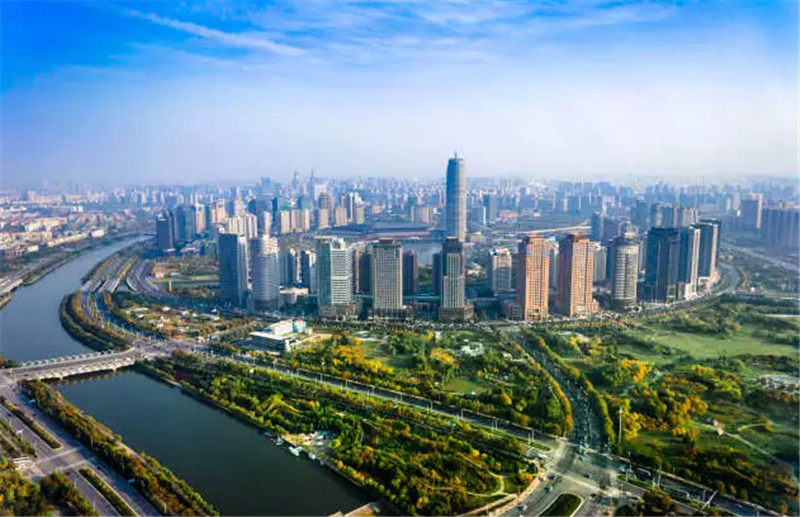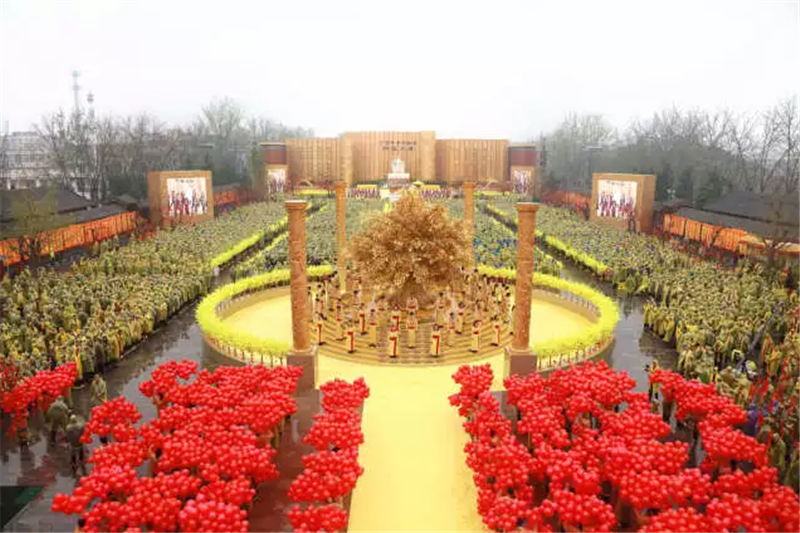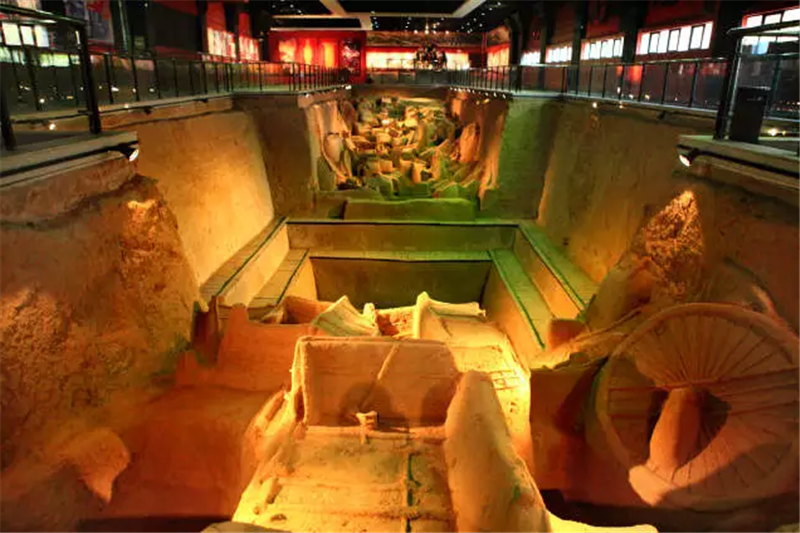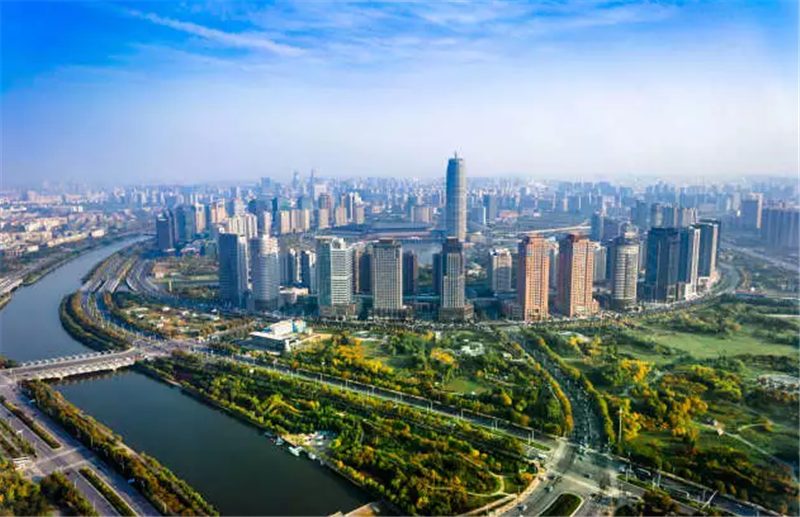Everyone Says “Zhong” after Visiting Zhengzhou

Located in the central part of China, Zhengzhou, the provincial capital of Henan, is the center of Nine Provinces. Lying on the southern bank of the Yellow River, near Songshan Mountain in the west, it serves as a “key hub”. Zhengzhou is an important central city in Central China, a major comprehensive national transportation hub, a core city in Central Plains Economic Zone, one of “National Famous Historical and Cultural Cities”, as well as one of the first batch of “China Excellent Tourism Cites”.
When it comes to Henan, everyone will think of “Zhong”, the Henan dialect, which means not only “direction” in Central Plains Mandarin, but also “affirmation” and “approval”. “Zhong” has the same impact as “a thumbs-up”. There is a new slogan for Zhengzhou, which is “Everyone Says “Zhong” after Visiting Zhengzhou”. It is very intimate and recognizable to read the slogan, a perfect combination of Henan’s dialect characteristics and the artistic conception of “Zhong”.
New Look of Zhengzhou
The past Zhengzhou has given people an impression of the “Largest County” with a filthy environment and unreasonable planning. However, with the implementation of over 10 national strategies and pilot platforms in Zhengzhou, including Zhengzhou Airport Economy Zone, China (Henan) Pilot Free Trade Zone, National Innovation Demonstration Zone and China (Zhengzhou) Cross-border E-commerce Comprehensive Pilot Zone, it has become the most competitive inland city through national policies, and kept improving its image with the development. China specifically supports Zhengzhou to be a National Central City, which brings Zhengzhou with unprecedented strategic opportunities. Zhengzhou’s tourism development, therefore, has stood at a new starting point in history.
With profound history and culture, Zhengzhou is both one of the Eight Ancient Capitals of China, and the important birthplace of Chinese civilization. Chinese ancestors lived here 8,000 years ago. During over 5,000-year history of Chinese civilization, Zhengzhou, along with its surrounding areas, has been China’s political, economic and cultural center in more than 3,000 years. The Duke of Zhou, through the astronomical measurement over 3,000 years ago, believed that Dengfeng (was known as Yangcheng) was a center of heaven and earth, and called Zhengzhou as well as a circumference of a thousand li “China”, which is the earliest documentary records of “China”. In the 21st century BC, the Xia dynasty, the earliest dynasty in Chinese history, established its capital in the Wangchenggang Site in Dengfeng. The age of Chinese civilization, therefore, has begun. The Chinese civilization thus comes from the civilization that was formed in Zhengzhou and continued to “take control the whole world”, and names after the geography of Zhengzhou—“the Center of Heaven and Earth”. There have been two world cultural heritages in Zhengzhou, as well as 43 Major Historical and Cultural Sites Protected at the National Level in 38 places, with the number ranking in the forefront among China’s prefecture-level cities.
Zhengzhou boasts abundant cultural and historical landscape. Here are the most popular tourist routes in Zhengzhou.
Tourism of Kung Fu and Meditation in Songshan Shaolin Temple

Songshan Mountain was named “Waifang” in ancient times, “Chonggao” and “Chongshan” in the Xia and Shang dynasties, “Yueshan” in the Western Zhou dynasty. Songshan Mountain was defined as the central mountain, called “Zhongyue Songshan”. Enjoying profound cultural deposits, it is the birthplace of China’s Zen Buddhism and the sacred site of Taoism. More than 30 emperors and over 150 well-known scholars have visited here. There is a famous line in the Classic of Poetry, “The precipitous Songshan Mountain is high and lofty to the sky”. Formed more than 3 billion years ago, Songshan Mountain is the first land in the Eurasia that emerges above sea level. Regarded as the “natural geological museum” of “five generations under one roof”—Archean Era, Proterozoic Era, Paleozoic Era, Mesozoic Era and Neozoic Era, it was included into the first global geopark by UNESCO in 2004. The Sanhuangzhai Scenic Area is the most fabulous place in Songshan Mountain, with bare cliffs, interlaced stone crevices and clearly demarcated blocks. In Sanhuangzhai, rambling on the walkway above the abyss, with the back against the steep cliff, you can see amazing peaks contend in beauty, and experience the “southern elegance and northern majesty” of China’s mountains.
There are six China’s top things in Songshan Mountain, including Shaolin Temple, the ancestral place of Zen Buddhism as well as the birthplace of the world-renowned Shaolin kung fu; Pagoda Forest at Shaolin Temple, the largest pagoda forest; Songyue Temple Pagoda—the oldest pagoda built in the Northern Wei dynasty; Three Han Que Gates, the oldest religious edifices; “General Cypress”, the oldest cypress royally named by Emperor of the Han dynasty; Gaocheng Astronomical Observatory, the earliest observatory built during the Yuan dynasty. In addition, Zhongyue Temple, the birthplace of Taoism, is the largest and the most complete Taoist building cluster among the Five Mountains. Songyang Academy, one of the Four Well-known Academies in the Northern Song dynasty, is home to the “New Confucianism”.
Songshan Mountain possesses a world cultural heritage—the historic buildings at “the Center of Heaven and Earth”, including 11 buildings in eight places, thus forming a 2,000-year visual and unique history of architecture in China and even the world. The ancient building group, with the longest time span, the most types of buildings and the most abundant culture in China, is the true embodiment of unique cosmology and aesthetics of ancient Chinese people.

Yellow River Cultural Tourism
The golden-bond-like Yellow River is nourishing Zhengzhou and its people. The demarcation point of the middle and lower reaches of the Yellow River is located in Peach Blossom Valley (Taohuayu), Zhengzhou, which is the end point of Loess Plateau and the starting point of North China Plain. As the saying of Chairman Mao goes, “Without the Yellow River, Chinese people would not have lived and bred”, the River has been nurturing Chinese people from the ancient time to the distant future. Numerous dotted scenic spots are scattering along the section of the Yellow River in Zhengzhou, including Yellow River Scenic Area with the world’s tallest sculptures of Emperors Yan and Huang, Kang Baiwan Manor—the residence of the Kang family, representative of Henan merchants, Heluo Conference where Fu Xi created the Eight Diagrams, and the chasm of Chu River and Han Border.

Tourism of Root Seeking and Ancestor Worshipping
Over five thousand years ago, Huang Emperor (also known as Yellow Emperor) was born, made an achievement, and founded the capital in Xinzheng of Zhengzhou, marking the origination of the civilization and surnames of Chinese people, the origin of the nation, and the birthplace of Huang Emperor culture. People said “Worshiping Xuanyuan on the third day of the third lunar month”, and over the past thousands of years, tens of thousands of Chinese people, who call themselves as the descendants of Huang Emperor, would gather at the hometown of Huang Emperor at that day and worship their ancestor here. Centered at Xinzheng and Xinmi, a lot of relics about Huang Emperor have been preserved. In the Hundred Family Surnames of China, 73 are from Henan Province including the 28 surnames (e.g. Zheng, Wang, Feng, and Han) from Zhengzhou.
Learning-based Tourism

In Henan, one tourism route is designed for history studying of Chinese dynasties. Within one hour by taking the G-series high-speed train, you can reach Anyang, Luoyang, and Kaifeng, all of which are listed among the Eight Ancient Capitals of China. The four time-honored cities have witnessed China’s history before the Southern Song dynasty, making it the best destination of the tourism for studying the history of China’s dynasties.
Another route is for studying poems in Tang and Song dynasties. Zhengzhou has gathered a lot of talents as the birthplace or the burial site for many representative celebrities who have written well-known poems. Du Fu, the Saint of Poem, and Bai Juyi, the King of Poem, were respectively born in Gongyi and Xinzheng of Zhengzhou. Ouyang Xiu, the figure of the Eight Masters of the Tang and Song dynasties, rests in peace in Xinzheng. In addition, Liu Yuxi, the “Hero Among Poets” in the Tang dynasty, who wrote the famous verse “A mountain needn’t be high; it is famous so long as there is a deity on it”, and Li Shangyin, who was famous for the saying “Flying without wings phoenix body, minds think alike”, both had their hometown in Xingyang.
As the hometowns or memorial parks of such figures have been developed into scenic spots, they became the ideal destinations to learn about traditional Chinese culture and the poems of the Tang and Song dynasties. In addition, since Zhengzhou is the birthplace of many proverbs and allusions, traveling in here will deepen students’ understanding of China’s traditional culture, history, literature, and geography.
To adapt to the era of leisure and holiday travel, Zhengzhou Fantawild Dreamland, CCRE • Huayi Brothers Film Culture Town, Haichang Ocean Park, “Only” Henan Theme Park, Central Plain Overseas Chinese Town, Yinji International Holiday Resort, Kungfu Tourism Town, and other modern tourism complexes are under construction or have been completed, inserting new dynamics in the tourism of Zhengzhou.

Guangzhou and Zhengzhou in Connection
As the traffic hubs, Guangzhou and Zhengzhou are connected by the shuttling high-speed trains and flights which have contributed to the more convenient and efficient exchanges and communication between the two cities. It is also believed that their tourist cooperation will reach win-win and fruitful achievements.